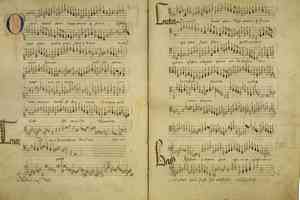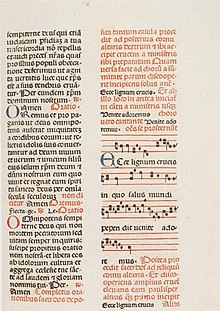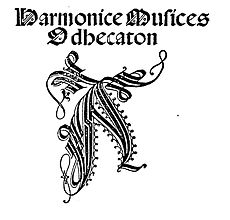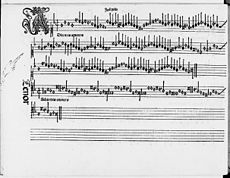


Score to Compère's
Omnium Bonorum Plena
Source:
Wikipedia
Born circa 1445, possibly in Belgium, Loyset Compère was among the many Franco-Flemish (Netherlandish) composers who contributed to the musical Renaissance. He would eventually become a French citizen by royal fiat in 1494. As Burgundy was fountainhead to the Franco-Flemish school, Loyset was educated in Burgundian styles of motet and chanson. He also completed two Masses ('Alles regrets' / 'L’homme armé') and four Magnificats. Compère and his music are firmly Renaissance, the long medieval grind of about a millennia faint in the rearview mirror and disappearing at the horizon to a lost age. Loyset (3 syllables) was a highly competent composer by the time of his earliest-known work, his Marian motet, 'Omnium Bonorum Plena', which may have been put together for the dedication of the Cambrai Cathedral in northern France on 2 July 1472. Tenor melody for this was based on Hayne van Ghizeghem's secular chanson, 'De tous bien pleine'. In the text Loyset includes himself among the great composers he mentions to be deserving of Mary's intercession. The work is found copied into the Trent 91 (I-TRbc MS 1378) transcribed circa 1460-80 and the Biblioteca Apostolica Vaticana (V-CVbav MS S. Pietro B.80) compiled 1474-75.
'Omnium Bonorum Plena' ('Full of All Good Things') Loyset Compère Poss 1472
Capella Sancti Michaelis w the Currende Consort directed by Erik van Nevel
Compère's earliest known employment was circa the early seventies at the chapel of Duke Galeazzo Maria Sforza in Milan. This was his first of two brief periods in Italy. But as Compère is among the first polyphonic composers to be published in movable type, and because publishing was a force which effected not only musical composition, but was a major bridge from the medieval into the Renaissance, we should have just a glance at printing. Though movable type wouldn't confront Compère for another quarter century, a few of the works below will refer to them.
Woodblock printing arrived sometime before 220 A.D. in China during the Han dynasty. During the Song dynasty one Bi Sheng devised movable type circa 1040 A.D.. Come the first official treasury notes during the Song in 1161. The printing press which spread the Renaissance arrived to Germany circa 1440, invented by the goldsmith, Johannes Gutenberg. Ulrich Han brought woodcut printing to Rome with his edition of Juan de Torquemada's 'Meditationes' in 1466 or 1467. Printing music, however, presented problems which Han overcame via movable type for the publication of the 'Missale Romanum' in 1476. Han was a German transplant to Italy who probably operated that country's first printing press. He solved the problem of the score by first printing the staff, then making a second impression of the notes.

Page from the 'Missale Romanum' printed by Ulrich Han in 1476
Well and good to print plainchant for a single voice, but polyphony needed a specialist. Albeit Han put many a volume to ink, they were by and large textual works, music not his expertise. He left that to Venetian, Ottaviano Petrucci (after which the Petrucci Music Library was named, now better known as IMSLP). The first book of polyphonic scores was Petrucci's 'Harmonice Musices Odhecaton' of 1501 in which the staves were pressed, then the notes, then the text. Like Han, Petrucci was a meticulous craftsman. Not only did everything line up, but now all variety of tiny symbols could be printed to complicate music.

Front cover of 'Canti A' of 'Harmonice Musices Odhecaton'
Printed by Ottaviano Petrucci in 1501

Page from 'Harmonice Musices Odhecaton' printed by Ottaviano Petrucci in 1501
The 'Harmonice Musices Odhecaton' of Venice is further divided into three volumes, the 'Canti A' of 1501, the 'Canti B' in 1502 and the 'Canti C' in 1504. Other books by Petrucci in which Compère appears, along with numerous others such as Josquin des Prez, are 'Motetti A' of 1502, 'Motetti B' of 1503 and 'Motetti C' of 1504. 'Fragmenta missarum' of 1505 contains 26 works including one by Compère. Such, then, are the first of what was to become the highly profitable business of sheet music.
We return to Compère's first time in Italy, that in the early-mid seventies in Milan under Duke Sforza when scores were yet put to ink by scribes with their folios entered into collections like the Trent 91 and Biblioteca Apostolica Vaticana above. Albeit uncertain, Compère's 'Ave Maria, gratia plena' may have been composed about this time, perhaps revised as late as the 1490s. It has been transcribed into numerous codices. 'Missa Galeazescha' ('Missa de Beata Maria Virgine') might have been written during this time as well. 'Missa Galeazescha' is one of three substitute masses (motetti missales) composed by Compère in which the Mass Ordinary or Proper are replaced by a cycle of motets. The 'Missa Galeazescha' is a cycle of eight parts replacing the standard five sung sections of the Mass (Kyrie, Gloria, Credo, Sanctus, Agnus Dei). Loyset's other two substitution masses are 'Ave Domine Jesu Christe' ('Missa de D.N.J.C') and 'Hodie nobis de virgine' ('Missa in Nativitate Deus Noster Jesu Christe'). Compère's motet cycle in nine parts for alto, bass and two tenors, 'Officium de Cruce', may have arrived as early as 1476. That is found in numerous codices, but the large portion of Compare's compositions elude specific dating and can be estimated widely. Among titles that are fairly certainly placed in Milan are Magnificats such as 'Anima mea dominum' which is the second of two composed for the sixth tone [Finscher]. Though intended for alto, bass and two tenors, it is rendered electronically at Early Music MIDI below. Stacking below could be an inexact match to actual chronology.
'Ave Maria gratia plena' ('Hail Mary full of grace')
Marian motet for 5 voices by Loyset Compère
Possibly as early as Milan under Sforza Published in Petrucci's 'Motetti A' 1502
Ensemble: Joli Cuer
'Virginis Mariae Laudis' Motet 8 of 8 from 'Missa Galeazescha'
Substitution mass by Loyset Compère
Possibly as early as Milan under Sforza
Odhecaton directed by Paolo Da Col
'In nomine Jesu' Motet 1 of 9 from 'Officium de Cruce' Motet cycle by Loyset Compère
Possibly as early as Milan under Sforza Published in Petrucci's 'Motetti B' 1503
New York Polyphony Album: 'And the Sun Darkened' on BIS
'Anima mea dominum' Magnificat 6 toni II [Finscher] Canticle for Vespers by Loyset Compère
Probably Milan under Sforza Published in Petrucci's 'Motetti B' 1503
Electronic by Early Music MIDI
Upon the murder of Duke Sforza on 26 December 1476 Compère's path becomes ambiguous. He probably returned to France where he may have served at the Court of Duke Jean II of Bourbon at some time during the eighties. His chanson for three voices, 'Vous me faites morir', might have arrived sometime in that decade. This work is found in the F-Pnm Français 2245 that was compiled for Louis d'Orléans before he became King Louis XII in 1498.
'Vous me faites morir' ('You make me die of wishing')
Chanson for 3 voices by Loyset Compère 1480s?
Jan Caals w the Currende Consort directed by Erik Van Nevel
It might have been the death of Jean II in 1488 that sent Compère to the Court of King Charles VIII. The chanson, 'Alons fere nos barbes', which appears in numerous codices may have arrived under Charles, that written for SATB (soprano, alto, tenor, bass).
'Alons fere nos barbes' ('Let's go be shaved') No earlier than 1488
Chanson for 4 voices by Loyset Compère Published in Petrucci's 'Canti A' of 1501
The Orlando Consort
Compère's second period in Italy arrived when King Charles too eagerly invaded the country in September of 1494 with a force of 25,000 troops including some Swiss, though his eye was on Naples to which he laid claim upon the death of Ferdinand I on 25 January that year. RateYourMusic gives 'Scaramella fa la galla' a date of 1494, as the title translates to 'Scaramella is going off to war'. Dickey (AllMusic) places it in Italy under Charles. 'Scaramella' is a secular frottola, a generic popular form from around 1470 to 1530 prior to the madrigal fashion. It was transcribed into the Basevi Codex put together sometime 1506-14 in Brussels, perhaps 1508. As Compère traveled with Charles on his Italian campaign, he may have written his motet for four voices, 'Crux triúmphans décus poténtium', in Rome as early as 1495. 'Crux Triumphans' is found in numerous manuscript collections including the Biblioteca Apostolica Vaticana (V-CVbav MS Capp. Sist. 15) compiled circa 1495 to 1500.
'Scaramella fa la galla' ('Scaramella is going off to war')
Frottola for 4 voices by Loyset Compère Likely 1494-95
'Crux triúmphans décus poténtium' ('Cross triumphant, jewel of power')
Motet for 4 voices by Loyset Compère Likely Rome 1495
Published in Petrucci's 'Motetti A' of 1502
Instrumental arrangement performed by Capella Sancti Michaelis
Charles' precipitous plunge down Italy's peninsula had put him in Naples in February. But that's as smooth as it got. Agreeable correspondence with powers in Italy hadn't been an invitation to make Italy a corridor to Naples. Though he had no designs against an unfriendly Papacy or Papal states his' military presence ruffled feathers and not all were happy with his occupation of Naples. Enter Savonarola who included Charles in his own crusade against Papal power. This would hasten his hanging by the Church for heresy on 23 May 1498. In the meantime, Charles found himself facing the League of Venice formed in March of 1495 consisting of several Italian states in alliance with Naples, the Holy Roman Empire and Spain, all working to block Charles' path back to France. Charles found passage, but to do it he had to win the Battle of Fornovo, consisting of three, on 6 July. Though Charles couldn't keep Naples, the movement of his army throughout Italy had been a virtual victory parade and he was soon back to his Court at the Château d'Amboise on the river Loire. He there died a month and a half before Savonarola on 7 April 1498, accidentally hitting his head at a doorway. He was only 27 years old and had been a king not quite four years. Despite that his excursion into Italy had been triumphant for his army throughout, he'd lost everything it gained, finally as suddenly, even the Château d'Amboise itself.
If Charles' life had been a brief flash of impulsive activity, Compère's own continued steadily onward with relatively less friction, so little that the chronology of it remains foggy. He'd been employed at the Church at Cambrai mentioned above sometime in 1498, and was at St. Pierre in Douai from 1500 to 1504 where he was provost the latter couple of years. 'Nous sommes de l'ordre de Saint Babouyn' is a chanson for SATB that probably arrived by 1500. Though it may have been composed considerably earlier I place it here only because it was published in 'Harmonice Musices Odhecaton' in 1501, the only date I have found associated with it. The incipit translates to 'We are of the Order of Saint Babouyn' further interpreted as 'We are of the Order of drunken fools'.
'Nous sommes de l'ordre de Saint Babouyn' ('We are of the Order of drunken fools')
Chanson for SATB by Loyset Compère No later than 1501
Published in Petrucci's 'Canti A' of 1501
Ensemble Clément Janequin directed by Dominique Visse
'Gaude Prole Regio' subtitled 'Sancta Catharina' is a motet likely written in 1501 toward the occasion of Philip the Handsome's visit to Paris that year. Philip was Duke of Burgundy, heart of the musical Renaissance, from 1482 to 1506, the year he became the first Habsburg King of Castile. This composition is included in the Biblioteca Nazionale Centrale (I-Fn MS II.I.232) housed in Florence that was transcribed 1515 to 1521.
'Gaude Prole Regio' ('Rejoice in your royal lineage')
Motet by Loyset Compère Probably 1501
Capella Sancti Michaelis
'Je suis amie du fourrier' is a chanson for 4 voices published in Petrucci's 'Canti B' in 1502 as was 'Le grant désir d'aymer me tient' for three voices, the latter the final score in that volume. The former is also found in numerous codices. The latter was added to Det Kongelige Bibliotek about 1525.
'Je suis amie du fourrier' ('I'm a friend of the quartermaster')
Chanson by Loyset Compère published in Petrucci's 'Canti B' of 1502
Capella Sancti Michaelis
'Le grant désir d'aymer me tient' ('The great desire to love holds me')
Chanson by Loyset Compère published No.56 in Petrucci's 'Canti B' of 1502
Le Banquet du Roy
Compère was finally employed at the Collegiate Church in Saint-Quentin where he died on 16 August 1518, certainly popular and among the finest composers of the time despite absence of documentation leaving him an atmospheric figure.
Sources & References for Loyset Compère:
VF History (notes)
Audio:
Compositions: Corpus:
Ludwig Finscher (CMM Editions)
Wikipedia (Italian)
Compositions: Individual (mentioned herein):
Alons fere nos barbes (chanson 1488 > under Charles VIII)
Ave Maria gratia plena (motet 1470s Milan under Duke Sforza):
Iain Fenlon (Early Music History: Studies in Medieval and Early Modern Music / Cambridge U Press 2009)
Crux triumphans (motet 1495 Rome under King Charles VIII):
Nous sommes de l'ordre de Saint Babouyn (chanson < 1500)
Omnium bonorum plena (motet 1472)
Scaramella fa la galla (frottola late 1494 - early 1495)
MSS (manuscript compilations): DIAMM
V-CVbav MS Capp. Sist. 15 (Vatican / c 1495-1500)
Recordings of Compère: Catalogs:
Discogs HOASM Music Brainz Presto Wikipedia
Recordings of Compère: Select:
Binchois Consort (Dufay: Missa Puisque je vis | Compère: Omnium bonorum plena)
New York Polyphony (And the Sun Darkened / BIS):
Odhecaton (Missa Galeazescha: Music for the Duke of Milan / Arcana):
Hyperion MusicWeb International MuziekWeb Outhere
The Orlando Consort (Loyset Compère / Hyperion):
ClassicalNet Hyperion MusicWeb International MuziekWeb
Review by Johan van Veen
Scores / Sheet Music:
Alons fere nos barbes (chanson 1488 > under Charles VIII)
Ave Maria gratia plena (motet 1470s < 1477 Milan under Duke Sforza)
Crux triumphans (motet 1495 Rome under King Charles VIII)
Gaude Prole Regio (motet 1501 Paris)
Officium de Cruce (motet 1476 >)
Nous sommes de l'ordre de Saint Babouyn (chanson < 1500)
Omnium bonorum plena (motet 1472)
Scaramella fa la galla (frottola late 1494 - early 1495):
Scores / Sheet Music: Various:
CPDL IMSLP Internet Archive Musicalics
Further Reading:
Daniel Ross Howard (Elements of Narrative in the Masses of Loyset Compère / U of Iowa 2010)
Bibliography:
Authority Search:
BNF VIAF WorldCatLudwig Finscher:
DIAMM
Loyset Compere and His Works (Musica Disciplina Vol. 12 / 1958)
Loyset Comprere: Life and Works (American Institute of Musicology / 1964)
Fabrice Fitch (Motetti Missales Cycle Ave Domine Jesu Christe / Research and Performance Practice Forum)
Marguerite de Navarre (Chansons Spirituelles / Georges Dottin 1971)
Lynn Halpern Ward (The Motetti Missales Repertory Reconsidered / Journal of the American Musicological Society Vol. 39 No. 3)
Other Profiles:
MEMUM Encyclopedia Miller TheatreSources & References for Printing:
Bi Sheng (movable type c 1040 A.D. China)
Fragmenta missarum (Petrucci 1505 / 26 pieces including Compère)
Johannes Gutenberg (printing press c 1440 Mainz)
Ulrich Han (woodcut printing & printing press / Rome)
Harmonice musices odhecaton (printed via movable type by Petrucci 1501):
Contents of Canti A, Canti B & Canti C: IMSLP
Original editions: CPDL
Missale Romanum (printed via movable type by Han 1476):
University of California Press
Motetti A (Petrucci 1502):
Helen Hewitt (Medieval Academy of America No. 42 / 1942)
Motetti B (Petrucci 1503):
Motetti C (Petrucci 1505): IMSLP
Movable type (c 1040 A.D. China)
Ottaviano Petrucci (Harmonice musices odhecaton printed via movable type 1501 Venice):
Ottaviano Petrucci: Publications:
Woodblock printing (< 220 A.D. China / woodcut in Europe)
Helpful Classical Music References:
Composers Works Directories & Thematic Catalogs: ClassicalNet
Classical Main Menu Modern Recording
hmrproject (at) aol (dot) com